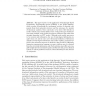Free Online Productivity Tools
i2Speak
i2Symbol
i2OCR
iTex2Img
iWeb2Print
iWeb2Shot
i2Type
iPdf2Split
iPdf2Merge
i2Bopomofo
i2Arabic
i2Style
i2Image
i2PDF
iLatex2Rtf
Sci2ools
PKDD
1999
Springer
1999
Springer
Predicting Chemical Carcinogenesis Using Structural Information Only
This paper reports on the application of the Strongly Typed Evolutionary Programming System
STEPS
to the PTE2 challenge, which consists of predicting the carcinogenic activity of chemical compounds from their molecular structure and the outcomes of a number of laboratory analyses. Most contestants so far have relied heavily on results of short term toxicity
STT
assays. Using both types of information made available, most models incorporate attributes that make them strongly dependent on STT results. Although such models may prove to be accurate and informative, the use of toxicological information requires time cost and in some cases substantial utilisation of laboratory animals. If toxicological information only makes explicit, properties implicit in the molecular structure of chemicals, then provided a su ciently expressive representation language, accurate solutions may be obtained from the structural information only. Such solutions may o er more tangible insight into the mecha...
| Added | 04 Aug 2010 |
| Updated | 04 Aug 2010 |
| Type | Conference |
| Year | 1999 |
| Where | PKDD |
| Authors | Claire J. Kennedy, Christophe G. Giraud-Carrier, Douglas W. Bristol |
Comments (0)

